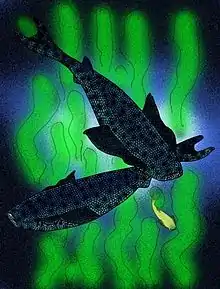| Thelodus Temporal range: Llandovery | |
|---|---|
 | |
| Comparison of T. parvidens and Loganellia | |
| Scientific classification | |
| Domain: | Eukaryota |
| Kingdom: | Animalia |
| Phylum: | Chordata |
| Infraphylum: | Agnatha |
| Class: | †Thelodonti |
| Order: | †Thelodontiformes |
| Family: | †Coelolepidae |
| Genus: | †Thelodus Agassiz, 1839 |
| Type species | |
| Thelodus parvidens | |
| Synonyms | |
| |
Thelodus (from Greek: θηλή thēlḗ, 'nipple' and Greek: ὀδούς odoús, 'tooth')[1] is an extinct genus of thelodont agnathan that lived during the Silurian period. Fossils have been found in Europe, Asia and North America.[2] Unlike many thelodonts, species of Thelodus are known not only from scales, but from impressions in rocks. Some species, such as the Canadian T. inauditus, are thought to be comparable in size to other thelodonts, i.e., from 5 to 15 centimeters in length.[3] The scales of the type species, T. parvidens (syn. T. macintoshi) of Silurian Great Britain, however, reach the size of coins, and, if proportioned like other thelodonts, such as Loganellia, the living animal would have been about one meter in length.[4]
References
- ↑ Jaeger, Edmund Carroll (1959). A source-book of biological names and terms. Springfield, Ill. : Thomas. p. 262. ISBN 978-0-398-00916-8.
- ↑ Thelodus at Fossilworks.org
- ↑ Märss, Tiiu, Mark VH Wilson, and Raymond Thorsteinsson. "New thelodont (Agnatha) and possible chondrichthyan (Gnathostomata) taxa established in the Silurian and Lower Devonian of the Canadian Arctic Archipelago." Proceedings of the Estonian Academy of Sciences, Geology. Vol. 51. No. 2. Estonian Academy Publishers, 2002.
- ↑ Turner, Susan. Thelodus Macintoshi Stetson 1928: The Largest Known Thelodont (Agnatha: Thelodonti). Museum of Comparative Zoology, 1986.
This article is issued from Wikipedia. The text is licensed under Creative Commons - Attribution - Sharealike. Additional terms may apply for the media files.
